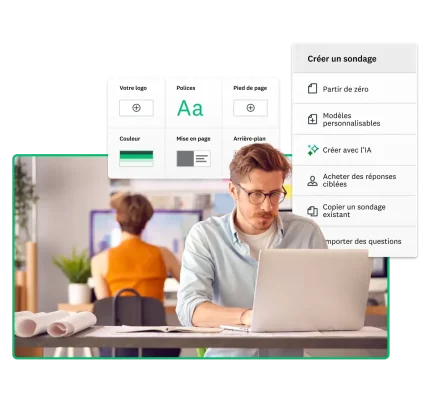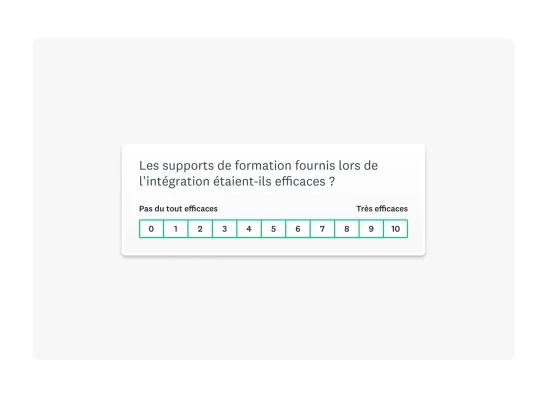Comment créer un questionnaire gratuitement ?
Utilisez notre outil de conception interactif, ou partez de l’un de nos modèles, puis envoyez votre questionnaire. Simple, rapide... Et gratuit !

- Concevoir un questionnaire en ligne implique de choisir avec pertinence les questions et les options de réponse, le barème de notation et les canaux de diffusion.
- Il existe des questionnaires pour plein de choses différentes : évaluations de formations, quiz amusants, tests de connaissances, et plus encore. Il est important de les adapter selon que leur objectif est pédagogique, évaluatif ou ludique.
- Pour qu’un questionnaire soit efficace, les questions doivent être claires, concises et en adéquation avec l’objectif fixé. Les options de réponses doivent aussi être transparentes et plausibles.
Si vous cherchez un moyen simple et rapide de créer gratuitement un questionnaire en ligne, nous avons ce qu’il vous faut ! L’outil de conception gratuit de SurveyMonkey vous permet non seulement de concevoir, de personnaliser et d’envoyer des questionnaires en ligne, mais également de collecter les réponses.
Dans cet article, nous allons vous expliquer comment créer, envoyer et optimiser un questionnaire avec SurveyMonkey, en illustrant nos propos par des exemples de questions.
Comment créer un questionnaire avec SurveyMonkey ?
SurveyMonkey propose une solution complète et gratuite pour vous simplifier la vie. Grâce à notre outil de conception de questionnaire, créez et envoyez facilement des questionnaires en ligne et recueillez les réponses en quelques minutes.
Voici comment procéder :
- Créez un compte SurveyMonkey gratuit ou connectez-vous à un compte existant, puis sélectionnez l’un de nos modèles de questionnaire en ligne. Ou alors, si vous avez une idée précise en tête pour créer votre propre quiz, sélectionnez « Partir de zéro ».
- Cliquez sur l’onglet Créer pour ajouter des questions.
- Pour chaque question, cochez la case « Noter cette question (activer le mode Quiz) ».
- Attribuez des points à chaque option de réponse en cliquant sur le signe Plus ou Moins.
- Envoyez votre questionnaire par email, chat, lien Web ou via les réseaux sociaux.
Transformez un sondage en questionnaire
Si vous avez l’habitude de créer des sondages avec SurveyMonkey, vous pouvez aussi utiliser cette méthode pour créer un questionnaire. Tout d’abord, inscrivez-vous pour créer un compte SurveyMonkey gratuit ou connectez-vous à votre compte. Sélectionnez Créer un sondage, puis Partir de zéro. Cliquez ensuite sur l’onglet Créer pour ajouter des questions au sondage et saisissez le texte de votre choix.
Si vous ne savez pas trop comment formuler vos questions, puisez dans notre Banque de questions prérédigées.
Utilisez un modèle de questionnaire SurveyMonkey
Si vous n’avez pas d’idée précise sur le contenu de votre quiz, vous pouvez utiliser l’un de nos modèles en ligne. Dans le menu d’en-tête, sélectionnez Créer un sondage, puis Modèles personnalisables. Dans le menu déroulant qui s’affiche, sélectionnez « Formulaires » pour parcourir toute notre collection.
Une fois que vous avez trouvé un modèle de questionnaire qui vous convient, sélectionnez Utiliser ce modèle.
Des questionnaires multiples et variés
Vous pouvez créer des questionnaires sur n’importe quel sujet, par exemple pour tester vos employés sur leurs connaissances après une formation juridique, ou par simple jeu, pour sonder vos amis sur leurs préférences en matière de cinéma.
Faisons un tour d’horizon de différents types de questionnaire.
Questionnaire d’évaluation de formation

Dans le cadre de leur intégration, les employés fraîchement recrutés doivent souvent suivre des formations en ligne, afin de se familiariser avec les procédures de l’entreprise ou avec certains éléments liés à leur nouveau poste. Mais combien d’entreprises prennent le temps d’évaluer le ressenti de ces employés à l’issue du processus, pour savoir s’ils se sentent prêts à prendre leurs nouvelles fonctions ? C’est précisément le but de notre modèle de sondage sur l’intégration des nouvelles recrues. À partir des résultats obtenus, vous pourrez effectuer les ajustements nécessaires pour améliorer l’intégration au sein de votre entreprise.
Après un module de formation, utilisez un questionnaire d’évaluation pour voir dans quelle mesure les employés ont mémorisé les points importants. Vous connaîtrez ainsi précisément le niveau de connaissances de chacun et pourrez identifier ceux qui ont besoin d’un soutien supplémentaire, tout en améliorant la formation et l’intégration des employés.
Les questionnaires permettent aussi de recueillir le feedback des employés sur leur expérience de formation. Avec notre modèle d’évaluation de formation, vous saurez entre autres si les employés seraient prêts à recommander la formation à leurs collègues. Au fil du temps, la collecte de feedback vous aidera à améliorer les formations que vous proposez à vos employés.
Grâce à SurveyMonkey, l’entreprise ORA Systems a ainsi décidé de transférer 82 cours de formation sur une même plateforme accessible à tous les employés. La plateforme de données centralisées des SurveyMonkey les a aidés à réorganiser leurs programmes de formations. Ainsi, les managers ont obtenu les données analytiques dont ils avaient besoin pour mieux comprendre les besoins des employés.
Test de connaissances et de compétences
Autre type de questionnaire très courant : les tests de connaissances et de compétences. Ils permettent par exemple aux entreprises de présélectionner des postulants à une offre d’emploi, ou d’évaluer les connaissances de leurs employés sur différents sujets.
À l’aide de notre modèle de formulaire d’évaluation des candidats, vous pouvez identifier les candidatures qui conviendraient le mieux à un poste donné. Des questions telles que « Comment évaluez-vous vos capacités de communication sur une échelle de 1 à 5 ? » vous aideront à sélectionner les bons candidats pour un entretien.
Pratiques et rapides à remplir, ces questionnaires sont très utiles pour recruter ou évaluer des employés.
Questionnaires éducatifs en ligne
De l’école primaire jusqu’aux études supérieures, les questionnaires d’évaluation sont largement utilisés par les professeurs. Il s’agit d’un moyen simple et rapide pour tester les connaissances et les acquis des élèves.
Suite à l’essor fulgurant de l’enseignement en ligne ces dernières années, ce type de questionnaire est devenu très populaire en raison de leur facilité de diffusion. Les enseignants peuvent activer une option pour afficher les résultats, ce qui permet aux élèves de voir les points où ils ont répondu correctement et ceux où ils se sont trompés.
SurveyMonkey propose une multitude de questionnaires et de sondages dédiés au secteur de l’éducation qui permettent aux établissements d’enseignement de recueillir de précieuses informations.
Des quiz pour s’amuser... Mais pas que !

Les quiz en ligne constituent un autre type de questionnaire très populaire. En famille, entre amis ou collègues, ils permettent de tester les connaissances des participants tout en s’amusant. Sports, musique, cinéma, actualités : les sujets ne manquent pas. Qu’est-ce qui vous retient d’organiser des soirées quiz ?
Au-delà du simple divertissement, les quiz sont des outils de cohésion d’équipe très efficaces. Ils encouragent la participation et créent des liens entre les membres d’une équipe. À l’issue du quiz, vous pouvez analyser les résultats pour déterminer quelle équipe a gagné et ainsi favoriser l’esprit de camaraderie et un sentiment d’accomplissement collectif.
Posez les bonnes questions
Un questionnaire efficace repose sur des questions pertinentes. Pour poser les bonnes questions, suivez ces quelques conseils :
- La simplicité avant tout : les questionnaires à rallonge sont dissuasifs. Soyez bref et concis. Et puis, les questions courtes limitent les ambiguïtés, ce qui améliore le taux de réponse.
- Diversifiez les options de réponse : faites en sorte que votre questionnaire parle à tout le monde. En proposant un large choix de réponses, vous augmentez les chances que les participants trouvent une réponse qui leur corresponde vraiment, au lieu de se rabattre sur une réponse par défaut.
- Évitez les questions biaisées et tendancieuses : ce type de question influence les participants en les incitant à répondre dans un certain sens. Si vous tombez dans cet écueil, votre questionnaire perdra en authenticité et vos résultats seront faussés.
- Ajoutez un compteur de questions : les participants risquent de se lasser de répondre à des questions s’ils n’ont aucune idée du temps que cela va leur prendre. Ajoutez donc un décompte pour que les participants puissent voir leur progression.
Pour des informations complètes et détaillées sur la rédaction des questions, regardez notre webinaire sur la conception des questions de sondage.
Conseils et bonnes pratiques
Les questionnaires en ligne sont simples et accessibles pour les personnes qui y répondent : vous obtiendrez un bon taux de participation et des réponses précises.
Voici quelques conseils pour améliorer encore le taux de réponse et la qualité des données collectées.
Utilisez des questions de sélection
Les questions de sélection servent à trier les participants à votre questionnaire. Si vous souhaitez interroger un groupe de personnes particulier, ces questions vous permettront de ne retenir que les personnes qui vous intéressent.
Il existe principalement deux types de questions de sélection : les questions comportementales et les questions sectorielles. Les premières s’intéressent au comportement des gens. Par exemple, « Combien d’heures lisez-vous par semaine ? » pour un questionnaire concernant les habitudes de lecture. Les personnes qui auront répondu 0 ne seront logiquement pas retenues pour ce quiz.
Les questions sectorielles s’intéressent au secteur d’activité et aux fonctions des participants. Par exemple, pour un questionnaire qui porte sur les compétences de votre service client, vous n’allez pas interroger des employés qui n’ont aucun contact avec la clientèle. Les questions de sélection permettent donc de filtrer les participants potentiels en excluant ceux auxquels le questionnaire ne s’applique pas.
Vous obtiendrez ainsi des données aussi exactes que possible, et vous ne ferez perdre de temps à personne avec des questionnaires mal ciblés.
À lire également : 5 conseils pour utiliser les questions de sélection dans vos sondages.
Choisissez les types de questions appropriés
L’efficacité d’un questionnaire dépend en partie des types de questions utilisés. Selon la situation, certains types de questions seront plus ou moins adaptés. Les questions à choix multiple, par exemple, conviennent bien aux questionnaires scolaires qui visent à tester les connaissances des élèves. Mais pour évaluer les compétences des employés, mieux vaut utiliser des questions de type échelle de Likert.
Pour bien choisir le type de question, il faut avant tout réfléchir à votre objectif. Certains questionnaires permettent d’indiquer les bonnes réponses aux participants, tandis que d’autres génèrent des données destinées uniquement à votre entreprise.
À lire également : Questions de sondage - Exemples et conseils d’experts.
Indiquez immédiatement leur score aux participants
Lorsqu’ils ont répondu à un quiz (et qu’ils y ont parfois passé du temps), les participants sont souvent impatients de connaître leurs résultats. Avec SurveyMonkey, il est possible d’afficher automatiquement la réponse dès que les participants répondent à une question. Dans ce cas, ils savent immédiatement si leur réponse est correcte ou non. Vous pouvez activer ou désactiver cette option selon le type de questionnaire créé.
Dans certains cas, il est essentiel d’indiquer leur score aux participants. C’est par exemple le cas des élèves ou des étudiants, qui sont généralement impatients de connaître leur note.
Foire aux questions
- Comment créer un questionnaire gratuit ?
- Qu’est-ce qui fait un bon questionnaire ?
- Quel est le meilleur outil de conception de questionnaires en ligne gratuits ?
Créez rapidement des questionnaires en ligne avec SurveyMonkey
Les questionnaires en ligne sont pratiques pour tester les connaissances et les compétences à des fins professionnelles, pédagogiques, ou tout simplement ludiques. Qu’il s’agisse de présélectionner des candidats pour un entretien d’embauche, ou de renforcer l’engagement des employés ou des étudiants, leur utilisation est très diversifiée.
Les outils de conception les plus performants comportent un système de notation automatique, des modèles de questionnaires, des méthodes de diffusion simples ainsi que des fonctionnalités efficaces de collecte et d’analyse des réponses. Notre plateforme combine tous ces avantages ! Avec SurveyMonkey, créez et envoyez des questionnaires en ligne en quelques minutes, gratuitement.
Lancez-vous sans plus attendre et créez votre propre questionnaire en ligne.
Prêt(e) à vous lancer ?
Discover more resources

Des solutions adaptées à votre rôle
Avec SurveyMonkey, maximisez l’impact de vos stratégies marketing, du développement de vos produits, de vos expériences client et plus encore.

Modèles de sondages
Créez et envoyez rapidement des sondages efficaces et attrayants grâce à SurveyMonkey et ses + de 400 modèles personnalisables et prêts à l’emploi.

Tout savoir sur les sondages avec chargement de fichier
Apprenez à utiliser un sondage avec fichier téléversé pour recueillir des informations supplémentaires et découvrez de nombreux exemples de questions.

Suivez le guide : calculateur de la valeur p
Utilisez notre calculateur dédié pour déterminer votre valeur p. Apprenez à calculer la valeur p et à l’interpréter en suivant notre guide détaillé.